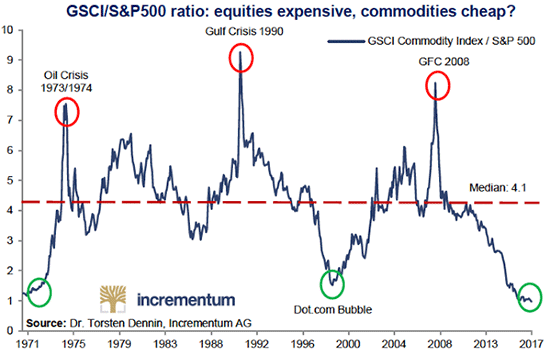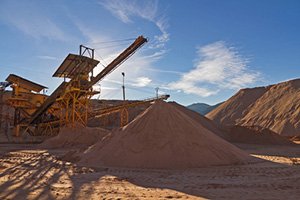More than any other sector, commodities are famous for good, old-fashioned booms and busts.
Commodities, of course, have been firmly in "bust mode" since 2011 - six years of ever-cheaper raw materials.
But there's some really compelling evidence that that's changing now. And I'm not alone - Goldman Sachs and PwC are with me here.
But what they won't tell you is how to pull down triple- or even quadruple-digit gains from this monumental shift in a totally despised sector.
I think conditions are perfect to do just that, and when you see these charts, I'm sure you'll agree...
Resources Are at the Point of Maximum Disdain
In the midst of a historic bull market, it's easy to overlook the fact that not one, but two of the most widely followed commodities indexes have fallen by over 60% between 2011 and 2016.
But that's exactly what happened.
Commodities had become so despised, there was no one left to sell.
But in early 2016, resource prices bottomed. They stopped falling and started rising, then moved sideways. This past summer, they pulled back, but - critically - established a higher low than in February last year.
The "Halley's Comet of Investing": Bill's seen this $13 billion "gold anomaly" just twice in 20 years. Continue reading...
 Since June 2017, commodities as a group are up an impressive 22%. And given the monstrous bear that's mauled the sector since 2011, the upside ahead promises to be epic.
Since June 2017, commodities as a group are up an impressive 22%. And given the monstrous bear that's mauled the sector since 2011, the upside ahead promises to be epic.
No investor can afford to overlook this profit potential.
And with the easy play I've got in mind, every investor can get out ahead of it.
You see, there's a little-known, specialized type of resource exploration company that's likely to be the most effective way for regular folks to gain exposure.
[mmpazkzone name="in-story" network="9794" site="307044" id="137008" type="4"]
These companies have considerable leverage on their underlying commodities while still providing a surprising amount of diversification for shareholders.
And the best part is... Many of these are primed to offer hundreds, and even thousands, of percent returns in the next few years.
Resources Are Historically Cheap... for Now
When analyzing this sector, it's well worth looking farther back, and then working our way forward to gain a sense of what may lie ahead.
A fascinating chart comparing the Goldman Sachs Commodity Index (GSCI) to the S&P 500 over the last 50 years provides some great insight.

Basically, this chart tells us if commodities are considered cheap, expensive, or somewhere in between, relative to stocks. Consider, too, that the GSCI is a broad index, including 24 different commodities covering all sectors.
When the ratio is high, it signals that commodities are expensive relative to stocks (red circles). And when the ratio is low, it tells us that commodities are cheap (green circles).
I said earlier that resources had become despised. And this chart proves it. The ratio is now at its lowest point in 50 years, and lower even than when the commodities bull market began, right around the turn of the 21st century.
Back then, resources began an extended cyclical bull market that lasted about eight years. Oil went from about $30 to an astounding $156. Copper soared from $0.70 per pound to over $4.40 in 2011.
Agricultural commodities experienced massive, multi-year up-legs, too.
Despite the housing and mortgage bubble, which popped in 2007, leading to the 2008-2009 financial crisis, many commodities roared higher for a few more years. But the perfect storm of China's slowing economy and a strengthening U.S. dollar finally caused resources to enter a multi-year bear market.
Rare... Fleeting... Perfect: Things are lining up beautifully for some truly uncommon precious metal profit potential. Click here to learn more...
Many commodities saw 65%, 80%, even 90% chopped off their prices. Yet those much lower prices set the stage for mine closure and massive production cuts, pulling supply off the market.
Those years of limited supply have given demand a chance to catch up and surpass, putting resource companies back in the driver's seat.
That's where the opportunity is right now...
Here's the Kind of Upside We Can Expect
According to Ned Davis Research, the median level between the GSCI and the S&P 500 is 4.1.
Getting back to just the median level from current lows means possibly over 300% returns.
But consider that resource bull markets don't normally stop at the median; they tend to soar much higher, to peak around 7 or 8. And that means returns for commodities as a whole could be on the order of 600% to 700% from here.
Another point to consider is how confidence has resumed in the junior mining sector.
PwC recently produced its report, entitled "Junior Mine 2017: Confidence Rekindled." It examines the Toronto Venture Exchange (TSXV), where nearly 1,000 mining/exploration companies are listed, comprising 47% of the exchange's total value and 59% of the volume traded.
The combined market caps of the top 100 such companies on the TSXV saw their total value increase 7% over the previous 12 months, reaching $12.2 billion. And these companies have been able to raise money and spend it at a much faster pace than last year.
What's more, IPOs and M&A activity have bounced back strongly too, all of which led Liam Fitzgerald, Canadian mining leader at PwC, to say, "Our junior mine report shows a brighter picture in 2017 than the industry has seen in several years. Increased exploration activity, financings, liquidity, and mergers and acquisitions show a renewed confidence in the sector."
And so, with this extremely bullish outlook in mind, I'm going to introduce you to three companies in the resource sector with a particular kind of business model.
They provide inherent diversification - always a good thing - and they also offer tremendous potential upside as the commodities bull kicks into high gear over the next few years.
Here's How to Play This Remarkable Bull
Prospect generators are a quirky subsector of the junior mining/exploration market. These companies are typically led by exploration geologists who generate prospective resource projects, then seek to joint-venture these projects with larger mining companies.
The beauty of this approach is that, despite the riskiness of exploration, other companies spend most of the money required to explore for and expand potentially economic deposits.
Midland Exploration Inc. (TSXV: MD.V) is a junior Canadian prospect generator, ably led by Gino Roger, the current president and CEO. Gino is a geological engineer and, for more than 25 years, worked as a project geologist, senior geologist, and regional geologist for Xstrata, Falconbridge, and Noranda.
The company focuses mainly on the province of Quebec, which is consistently ranked as one of the top mining jurisdictions in the world. The company focuses on gold, platinum group metals, and base metals. The company is well-run, with no debt, $12 million in cash, and 8% of shares owned by management.
 Current significant option agreements are helping to advance a number of highly prospective projects. Partners on these projects include some of the biggest names in mining, including Teck, Agnico Eagle, Iamgold, Altius, Osisko, JOGMEC, and NioBay.
Current significant option agreements are helping to advance a number of highly prospective projects. Partners on these projects include some of the biggest names in mining, including Teck, Agnico Eagle, Iamgold, Altius, Osisko, JOGMEC, and NioBay.
This year alone, Midland will see $8 million of exploration, consisting of more than 25,000 meters of drilling. And recent highlights include new, high-grade gold veins on its Willbob project, a new zinc-bearing belt discovered on an Altius joint venture, and a new option agreement with Iamgold.
With so many gears turning in such a great jurisdiction, Midland dramatically ups the odd of finding the next world-class deposit.
Millrock Resources Inc. (TSXV: MRO.V) is, much like Midland, a project generator. The one main difference that is perhaps most obvious is that Millrock has projects in multiple jurisdictions: Alaska, British Columbia, Southwestern U.S.A., and Mexico. At the helm is Gregory Beischer, a seasoned explorationist who's worked with Inco and the Bristol Bay Native Corp. CEO is Philip St. George, who helped discover the Pebble deposit in Alaska and worked on defining an additional 12 million ounces on the Donlin Creek resource.
Part of the company's assets include shares in other mining and exploration companies, which are currently valued at about $2.6 million. And despite a modest $1 million in cash, this can last for some time, as the company earns management fees from option agreement payments.
Despite participating in the earliest stages of exploration, Millrock stands to benefit from the upside it retains in joint-ventured projects. The company explicitly states its objective is to "find a giant orebody and move it through to feasibility before selling out interest." Going back to 2008, just 14% of Millrock's exploration spending has been funded internally, with the balance of 86% being partner-funded.
Millrock currently boasts 25 different projects that are partnered with or operated for Kinross, Centerra Gold, PolarX, Coventry Resources, and Sojourn Ventures.
Like Midland, Millrock is a riskier bet on this sector. But the business model of project diversification and joint ventures, along with stellar management, help to dramatically minimize the inherent uncertainties. The upside potential remains very promising indeed.
Altius Minerals Corp. (TSX: ALS.V) is, by far, the much bigger brother of Midland and Millrock. In fact, Midland has a strategic alliance with Altius in the James Bay region of Quebec. I consider ALS to be somewhat of a hybrid of the project generator and royalties/streaming business models. At its founding back in 1997, Altius President and CEO Brian Dalton had this approach in mind.
His 20-year tenure has helped grow the corporate asset base by more than $500 million. Today, the company holds 15 diversified royalties and streams generating revenue from 15 operating mines in Canada and Brazil, producing copper, zinc, nickel, cobalt, iron ore potash, as well as thermal and metallurgical coal. Beyond this, Altius holds pre-development-stage royalties in numerous jurisdictions covering many different commodities.
On the prospecting side, ALS also boasts a large portfolio of exploration-stage projects in Chile, Australia, Finland, Ireland, the United States, and Canada.
The company's royalty revenue is currently worth about $55 million for fiscal 2018. Its market cap is $524 million, and it pays a reasonable 1% dividend yield. And hidden beneath the surface are founding equity stakes and equity investments in select junior exploration companies worth $60 million.
Overall, Altius is a top way to play the renewed commodities super cycle. As stocks eventually peak and investors seek value, this is the sector most likely to benefit.
Up Next: We Couldn't Believe We Were Seeing This
Bill Patalon's gold charts are showing an "event" unfolding - something that's happened just twice in the past 20 years - that's packing some incredible profit potential. Click here to keep reading...
Follow Money Morning on Twitter @moneymorning, Facebook, and LinkedIn.


